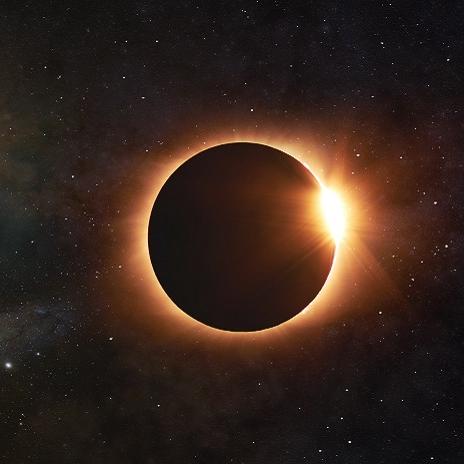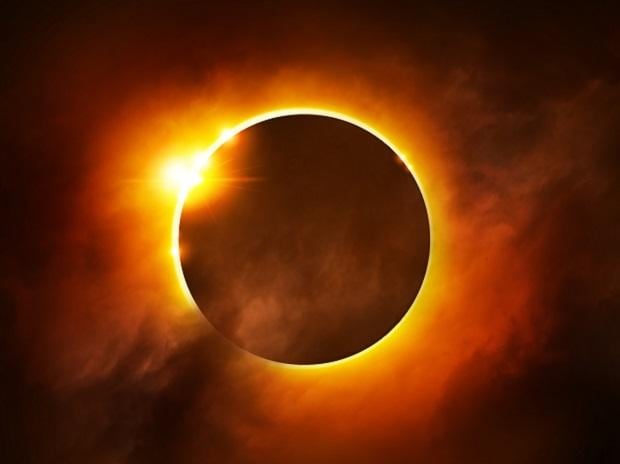WHAT IS SOLAR ECLIPSE

Solar Eclipse
A solar eclipse takes place when the Moon moves between the Sun and the Earth, blocking out the Sun's rays and casting a shadow on parts of the Earth.
How does solar eclipse occur?
For a solar eclipse to take place, the Sun, the Moon, and the Earth must be aligned in a perfect or near-perfect straight line – an alignment astronomers call syzygy. This happens around new Moon every lunar month.
Types of solar eclipse
There are four types of solar eclipses. How much of the Sun's disk is eclipsed – the eclipse magnitude – depends on which part of the Moon's shadow falls on the Earth.
A partial solar eclipse occurs when the Moon only partially obscures the Sun's disk and casts only its penumbra on the Earth.
An annular solar eclipse takes place when the Moon's disk is not big enough to cover the entire disk of the Sun, and the Sun's outer edges remain visible to form a ring of fire in the sky. An annular eclipse of the Sun takes place when the Moon is near apogee, and the Moon's antumbra falls on the Earth.
A total solar eclipse happens when the Moon completely covers the Sun. It can take place only when the Moon is near perigee, the point of the Moon's orbit closest to the Earth. You can see a total solar eclipse only if you are in the path where the Moon casts its darkest shadow, the umbra.
A hybrid solar eclipse, also known as an annular-total eclipse, is the rarest type. It occurs when the same eclipse changes from an annular to a total solar eclipse, and/or vice versa, along the eclipse's path.
When is the next solar eclipse?
June 21, 2020: Solar Eclipse (Annular) in South/East Europe, Much of Asia, North in Australia, Much of Africa, Pacific, Indian Ocean
December 14, 2020: Solar Eclipse (Total) in southern parts of Africa, much of South America, Pacific, Atlantic, Indian Ocean, Antarctica
June 10, 2021: Solar Eclipse (Annular) in much of Europe and Asia, North/West Africa, Much of North America, Atlantic, Arctic
December 4, 2021: Solar Eclipse (Total) in South Australia, southern Africa, South in South America, Pacific, Atlantic, Indian Ocean, Antarctica
April 30, 2022: Solar Eclipse (Partial) in South/West South America, Pacific, Atlantic, Antarctica
How to see solar eclipse?
Never look directly at the Sun, eclipsed or otherwise, without any protective eyewear. The Sun’s UV radiation can burn the retinas in your eyes leading to their permanent damage or even blindness.
The best way to safely watch a total solar eclipse is to wear protective eclipse glasses or to project an image of the eclipsed Sun using a pinhole projector.
Difference between solar eclipse and lunar eclipse
A lunar eclipse occurs when the Earth passes between the Moon and the Sun, and the Earth's shadow obscures the Moon or a portion of it. A solar eclipse occurs when the Moon passes between the Earth and the Sun, blocking all or a portion of the Sun.
SOLAR ECLIPSE NEWS
-
 Four eclipse events this year, two would be visible in India: Astro expert
Four eclipse events this year, two would be visible in India: Astro expert
Four eclipse events including a total solar eclipse would occur in 2023 and two of them would be visible in India, an astronomy ...| January 04, 2023, Wednesday -
 Treat eclipses as natural celestial event: Astrophysicist on superstitions
Treat eclipses as natural celestial event: Astrophysicist on superstitions
An eminent astrophysicist has called for treating eclipses as natural celestial events and not believe in superstitions ...| November 08, 2022, Tuesday -
 Last lunar eclipse of 2022: Why does the Moon appear red during this event
Last lunar eclipse of 2022: Why does the Moon appear red during this event
Unlike solar eclipses, there are no harmful rays emitted during a lunar eclipse, so it's safe to watch it with the naked eyes| November 08, 2022, Tuesday -
 Several temples in Telangana closed due to solar eclipse: Official
Several temples in Telangana closed due to solar eclipse: Official
Many important temples in Telangana remain closed on Tuesday due to solar eclipse, a senior official of the Endowments Department ...| October 25, 2022, Tuesday -
 Badrinath-Kedarnath temple doors to remain closed on Oct 25 solar eclipse
Badrinath-Kedarnath temple doors to remain closed on Oct 25 solar eclipse
Doors of Shri Badrinath-Kedarnath temple will remain closed on October 25 on the solar eclipse, said the temple committee| October 23, 2022, Sunday -
 Partial solar eclipse on Oct 25 will be visible from most parts of India
Partial solar eclipse on Oct 25 will be visible from most parts of India
During the Diwali festival on October 25, there will be a partial solar eclipse which will be visible from the city as well as ...| October 11, 2022, Tuesday -
 Solar Eclipse 2021: How and where to watch, eclipse timing, and more
Solar Eclipse 2021: How and where to watch, eclipse timing, and more
First, the partial eclipse will start at around 11:42 am IST and the annular eclipse will appear to occur from 3:30 pm and will ...| June 10, 2021, Thursday -
 Astronomer discovers rare comet flying past Sun during total solar eclipse
Astronomer discovers rare comet flying past Sun during total solar eclipse
Around the time the eclipse image was taken, the comet was travelling at roughly 7,24,205 kms per hour, about 4.3 million kms ...| December 20, 2020, Sunday -
 Sun enters 25th solar cycle: 'Violent eruptions can happen anytime'
Sun enters 25th solar cycle: 'Violent eruptions can happen anytime'
Solar cycle predictions hold significance as it gives a rough idea of the frequency of space weather storms of all types| September 16, 2020, Wednesday -
 Solar eclipse 2020 in pictures: Images from different parts of India, world
Solar eclipse 2020 in pictures: Images from different parts of India, world
The solar eclipse will be visible until 3.04 pm and the maximum eclipse will take place at 12:10 IST| June 21, 2020, Sunday
